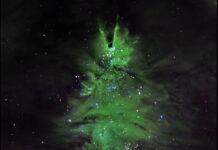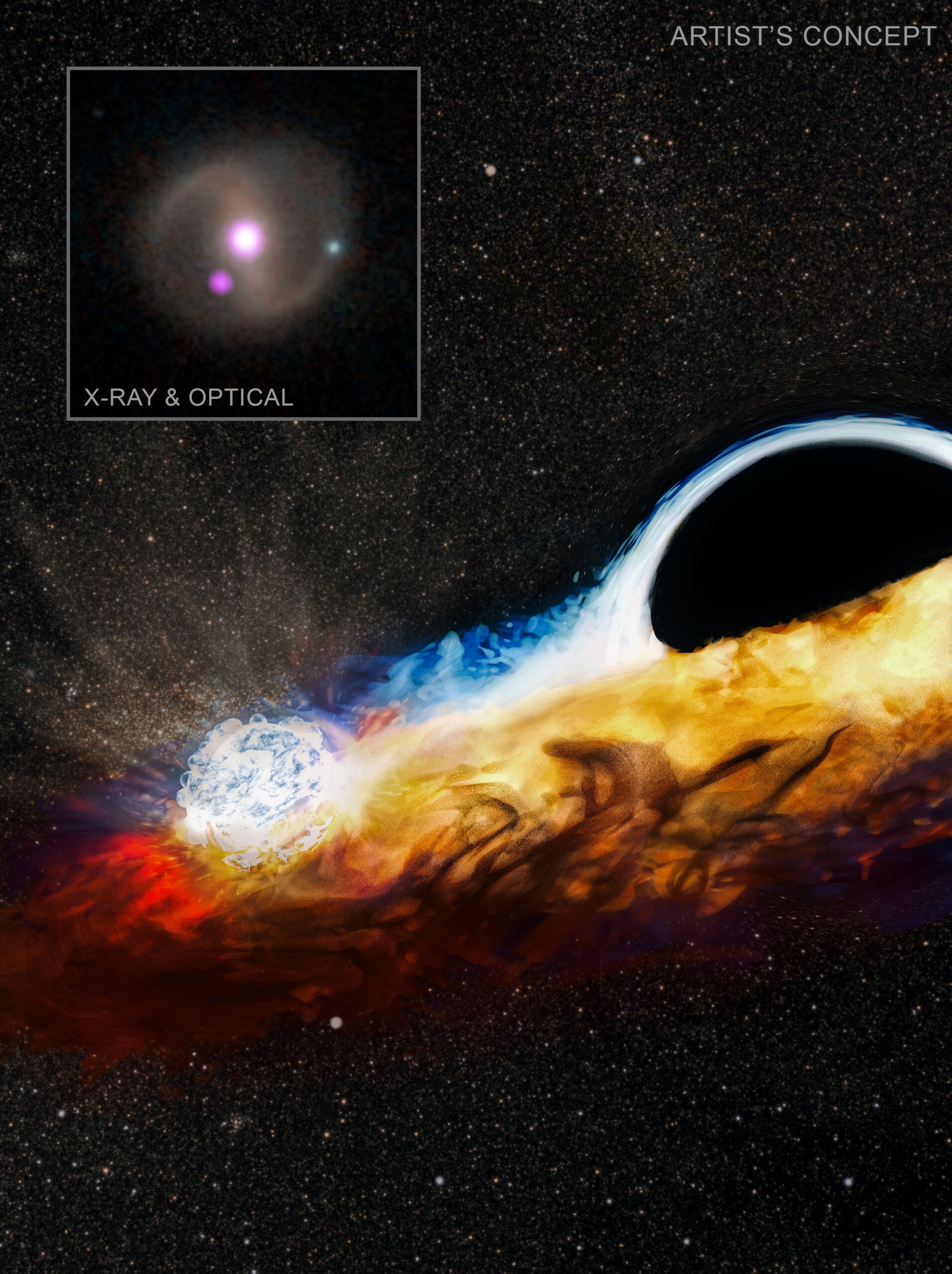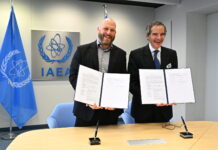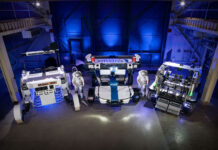NASA’s Chandra X-ray Observatory Unveils New Insights into Cosmic Mysteries
NASA’s Chandra X-ray Observatory, along with several other telescopes, has recently made a groundbreaking discovery involving a supermassive black hole. This celestial giant has not only torn apart a star but is now using the remnants of this stellar destruction to bombard another celestial body, possibly another star or a smaller black hole. This discovery, detailed in a recent press release, bridges two significant cosmic phenomena and sheds light on the environments surrounding some of the largest known black holes.
Understanding the Cosmic Event
The event in question has been illustrated by artists to help visualize the complex interactions occurring in deep space. The depiction shows a disk of material, composed of red, orange, and yellow hues, forming after a supermassive black hole shreds a star using its intense gravitational forces, known as tidal forces. Over several years, this disk expanded and eventually collided with another celestial object, which could either be a smaller star or a diminutive black hole orbiting the larger black hole. Every time this object crashes into the disk, it results in a burst of X-rays, which are detected by telescopes such as Chandra. The observations also include optical data from the Pan-STARRS telescope, adding another layer of detail to the findings.
The Discovery Journey
The story began in 2019 when an optical telescope in California detected an unexpected burst of light. Astronomers quickly classified this burst as a “tidal disruption event” (TDE), which occurs when a black hole’s gravitational pull is strong enough to rip apart a star that ventures too close. This particular TDE was named AT2019qiz. At the same time, researchers were examining another cosmic phenomenon: periodic bursts of X-rays near supermassive black holes, known as “quasi-periodic eruptions” (QPEs).
The new study suggests a potential connection between TDEs and QPEs. The researchers propose that QPEs might occur when an object collides with the debris disk left behind by a TDE. While other explanations might exist, this hypothesis provides a plausible origin for at least some QPEs.
Collaborative Observations from Multiple Telescopes
In 2023, astronomers used both the Chandra and Hubble telescopes to simultaneously study the aftermath of the tidal disruption event. Chandra’s observations, conducted over three separate sessions spaced four to five hours apart, resulted in a total of 14 hours of data. These sessions revealed a weak signal in the first and last observations but a significantly stronger one in the middle, indicating an intriguing pattern.
To further investigate, researchers employed NASA’s Neutron Star Interior Composition Explorer (NICER) to frequently monitor AT2019qiz for repeated X-ray bursts. NICER’s data revealed that these bursts occurred roughly every 48 hours. Additional data from NASA’s Neil Gehrels Swift Observatory and India’s AstroSat telescope confirmed these findings.
The ultraviolet data from Hubble, gathered concurrently with the Chandra observations, allowed scientists to estimate the size of the disk surrounding the supermassive black hole. The disk had expanded enough that if any object was orbiting the black hole with a period of a week or less, it would inevitably collide with the disk, triggering these eruptions.
Implications for Future Research
The results of this study have significant implications for future research into quasi-periodic eruptions linked to tidal disruptions. Identifying more of these events would enable astronomers to better understand the abundance and distances of objects in close orbits around supermassive black holes. Some of these objects could become excellent targets for future gravitational wave observatories, which are currently in the planning stages.
The research findings were published in the October 9, 2024 issue of the journal Nature. The lead author of the study is Matt Nicholl from Queen’s University Belfast in Ireland. The full list of contributors can be accessed in the paper, which is available online at [arXiv](https://arxiv.org/abs/2409.02181).
The Role of Chandra and the Smithsonian Astrophysical Observatory
NASA’s Marshall Space Flight Center oversees the Chandra program, while the Smithsonian Astrophysical Observatory’s Chandra X-ray Center manages scientific operations from Cambridge, Massachusetts, and flight operations from Burlington, Massachusetts. These organizations play a crucial role in facilitating groundbreaking astronomical research, as evidenced by this recent discovery.
For those interested in learning more about the Chandra X-ray Observatory and its mission, additional information can be found on the following websites:
– [NASA’s Chandra X-ray Observatory](https://www.nasa.gov/chandra)
– [Chandra X-ray Center](https://chandra.si.edu)
Visualizing the Destructive Power of Black Holes
The accompanying artist’s rendering vividly illustrates the destructive capabilities of a supermassive black hole. The image portrays a disk of stellar material encircling the black hole, with a neighboring star colliding with and passing through the disk. The black hole itself is depicted as a jet-black semicircle with a pale blue glow at its peak. The disk, viewed edge-on, consists of swirling gas in shades of yellow, orange, and red, cutting diagonally across the image.
Near the lower left corner, the edge of the stellar debris disk overlaps with a bright blue sphere, representing a neighboring star crashing through the disk. This collision releases X-rays, which are detected by Chandra, providing valuable data for researchers.
This discovery not only enhances our understanding of black holes and their interactions with surrounding celestial objects but also opens new avenues for exploring the mysteries of our universe. As scientists continue to unravel these cosmic phenomena, the potential for further groundbreaking discoveries remains vast and exciting.
For more Information, Refer to this article.


































